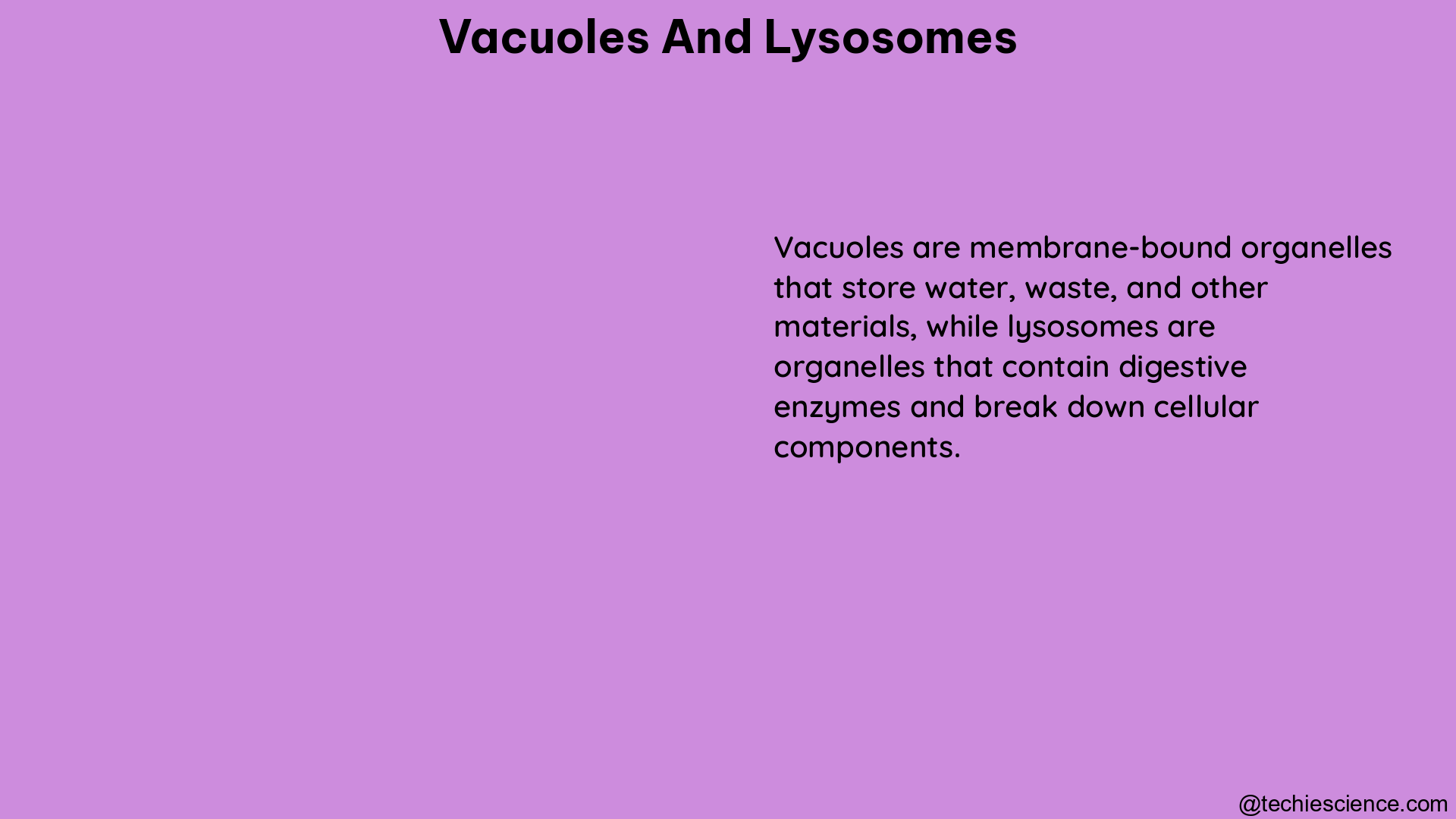Vacuoles and lysosomes are essential organelles in eukaryotic cells that play crucial roles in various cellular processes, including degradation, nutrient sensing, intracellular signaling, and metabolism. These specialized compartments are responsible for the breakdown and recycling of cellular components, as well as the regulation of important signaling pathways that govern cellular homeostasis and adaptation.
Morphology and Positioning of Vacuoles and Lysosomes
Lysosomes are typically round organelles with a diameter ranging from 0.1 to 0.5 micrometers (µm). In contrast, vacuoles in plant cells can be much larger, reaching several micrometers in diameter. The morphology and positioning of these organelles can be analyzed using various microscopy techniques, such as transmission electron microscopy (TEM), confocal microscopy, and super-resolution microscopy.
- Lysosome Morphology and Positioning: A recent study using quantitative high-content image analysis revealed that lysosomes occupy approximately 0.5-1% of the cell volume in human retinal pigment epithelial cells. This data provides a quantitative measure of the relative abundance and distribution of lysosomes within the cellular landscape.
- Vacuole Morphology and Positioning: In plant cells, vacuoles can account for up to 90% of the total cell volume, making them the largest organelles. The size and number of vacuoles can vary depending on the plant species, cell type, and developmental stage. Vacuoles are typically located in the center of the cell, surrounded by the cytoplasm and other organelles.
Motility of Vacuoles and Lysosomes

Lysosomes are highly dynamic organelles that can move within the cell, driven by microtubule-based motor proteins. The motility of lysosomes can be quantified by tracking their movement over time using live-cell imaging techniques, such as spinning disk confocal microscopy.
- Lysosome Motility: A study using spinning disk confocal microscopy found that lysosomes move at an average speed of 0.3-0.5 µm/s in human fibroblasts. This data provides a quantitative measure of the mobility of lysosomes within the cellular environment.
- Vacuole Motility: In plant cells, vacuoles can also exhibit dynamic movement, driven by the actin cytoskeleton and myosin motor proteins. The motility of plant vacuoles is essential for their role in intracellular trafficking and the distribution of nutrients and signaling molecules throughout the cell.
Functions of Vacuoles and Lysosomes
Lysosomes are involved in various cellular functions beyond their well-known degradative role. These organelles play a crucial role in nutrient sensing and intracellular signaling by regulating the mTOR signaling pathway, a key regulator of cell growth and metabolism.
- Degradative Function: Lysosomes contain a variety of hydrolytic enzymes, such as proteases, lipases, and nucleases, which are responsible for the breakdown of macromolecules. The activity of these enzymes can be measured using lysosomal enzyme activity assays.
- Nutrient Sensing and Signaling: Lysosomes act as nutrient sensors, monitoring the availability of amino acids and other nutrients within the cell. This information is then relayed to the mTOR signaling pathway, which coordinates cellular growth, proliferation, and metabolism in response to nutrient availability.
- pH Regulation: Lysosomes maintain an acidic pH (around 4.5-5.0) within their lumen, which is essential for the optimal activity of their hydrolytic enzymes. The lysosomal pH can be measured using fluorescent pH-sensitive dyes or ratiometric imaging techniques.
- Vacuole Functions: In plant cells, vacuoles serve a variety of functions, including storage of water, nutrients, and waste products, as well as the regulation of cellular pH, turgor pressure, and ion homeostasis. Vacuoles can also play a role in the compartmentalization of toxic compounds, protecting the cytoplasm from harmful substances.
Regulation of Lysosomal Function
Lysosomal function is regulated by various factors, including the transcription factor EB (TFEB), a master regulator of lysosomal biogenesis and function. The activity of TFEB can be quantified by measuring its nuclear localization using immunofluorescence microscopy or western blotting.
- TFEB Regulation: TFEB activity is regulated by the lysosomal Ca2+ signaling pathway, which can be measured using whole-endolysosome patch-clamp recordings. Activation of TFEB leads to the transcriptional upregulation of genes involved in lysosomal biogenesis and function, thereby enhancing the cell’s degradative and signaling capabilities.
- Calcium Signaling: Lysosomes are also involved in the regulation of intracellular calcium (Ca2+) levels, which can influence a variety of cellular processes, such as membrane trafficking, signaling, and gene expression. The role of lysosomes in Ca2+ homeostasis can be studied using fluorescent Ca2+ indicators and live-cell imaging techniques.
- Membrane Integrity: The integrity of the lysosomal membrane is crucial for maintaining the acidic environment within the lumen and preventing the leakage of hydrolytic enzymes into the cytoplasm. The lysosomal membrane integrity can be assessed using assays that measure the release of lysosomal contents, such as the lactate dehydrogenase (LDH) assay.
In summary, vacuoles and lysosomes are essential organelles that play a vital role in the maintenance of cellular homeostasis, nutrient sensing, signaling, and metabolism. The quantitative and measurable data on their morphology, positioning, motility, and function provide valuable insights into the complex and dynamic nature of these organelles, which are crucial for understanding cellular physiology and pathology.
References:
- Barral, D. C., Staiano, L., Guimas Almeida, C., & Gomes, A. Q. (2022). Current methods to analyze lysosome morphology, positioning, motility and function. Traffic, 23(5), 238-269. https://doi.org/10.1111/tra.12839
- Barral, D. C., & Seabra, M. C. (2019). Lysosomes: from degradation to signaling. Nature Reviews Molecular Cell Biology, 20(12), 749-764. https://doi.org/10.1038/s41580-019-0201-z
- Samie, F. Y., Xu, Y., Schulze, K. L., Foehr, M., & Liao, R. (2020). LRRC8 family proteins within lysosomes regulate cellular vacuolation and lysosomal function. Nature Communications, 11(1), 5534. https://doi.org/10.1038/s41467-020-19290-6
- Marty, F., Hatakeyama, S., & Hirokawa, N. (2019). Lysosome positioning by microtubule motors: a key step in the regulation of cellular clearance. Nature Reviews Molecular Cell Biology, 20(12), 731-748. https://doi.org/10.1038/s41580-019-0200-0
Hi …I am Tulika Priyadarshini, I have completed my Master’s in Biotechnology. Writing gives me mental peace and satisfaction. Sharing the knowledge that I gain in the process is a cherry on the cake. My articles are related to Lifesciences, Biology and Biotechnology. Lets connect through LinkedIn-